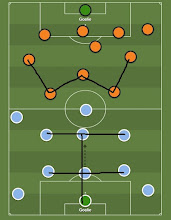The 1983 U20 World Cup is remembered for its success in drawing huge crowds
to the stadiums, just like senior-level tournaments.
Facts and
Figures from the 1983 U20 World Cup
* The tournament took place from 2 to 19 June with 16 teams divided into
four groups.
* A total of 32 matches were played throughout the tournament.
* The host cities were Guadalajara, Mexico City, León, Irapuato, Monterrey,
Toluca, and Puebla.
* Europe was represented by the semifinalists of the UEFA U18 Championship
plus two group runners-up, determined by points, goals scored, and aggregate
difference. They were Scotland, Poland, Czechoslovakia, and the Soviet Union,
with the Netherlands and Austria qualifying as the two best runners-up.
* The USA youth team took part in place of Honduras, winners of the 1982 CONCACAF U20 Championship, who were disqualified.
Two CONMEBOL Classic Rivals Shine
Two South American rivals, Brazil and Argentina, stole the spotlight in this edition. Both marched into the final unbeaten, delivering impressive performances along the way. La Albiceleste did not concede a single goal in the group stage. Jorge Borelli and teammates continued their strong run in the knockouts, defeating the Netherlands — led by rising star Marco van Basten — 2–1 in the quarter-finals, before edging past Poland 1–0 in the semi-finals.
Brazil’s young side was equally dominant. After going undefeated in the group stage, Carlos Dunga and Co thrashed Czechoslovakia 4–1 in the quarter-finals and overcame South Korea — who had shocked hosts Mexico and Uruguay earlier — 2–1 in the semis.
Unfortunately, the much-anticipated final between the two giants produced few goals. In front of 110,000 fans at the Azteca Stadium, the Seleção youth team narrowly defeated their fierce rivals 1–0. Geovanni scored the decisive goal from the penalty spot in the 39th minute. Brazil were crowned champions, claiming their first-ever U20 World Cup title in 1983.
Tournament Highlights
|
Group A |
Group B |
Group C |
Grup D |
|
Scotland |
Uruguay |
Argentina |
Brasil |
|
South Korea |
Poland |
Czechoslovakia |
Netherlands |
|
Australia |
USA |
PRC |
Nigeria |
|
Mexico |
Ivory Coast |
Austria |
USSR |
** = penalties
* = extra time
-
Scotland
vs Poland 0-1
-
Uruguay
vs South Korea 1-2*
-
Argentina
vs Netherlands 2-1
-
Brasil
vs Czechoslovakia 4-1
-
Poland
vs Argentina 0-1
- South Korea vs Brasil 1-2
3rd Place Playoff: Poland vs South Korea 2-1*
Final: Brasil vs
Top scorer: Geovani Faria
(Brasil) – 6 gol
MVP: Geovani Faria (Brasil)
From Youth to Stardom
Compared to the previous three editions, quite a number of star players emerged from Mexico 1983. Among them were Marco van Basten and Gerald Vanenburg, who became key figures in the Netherlands’ Euro 1988 triumph; Dunga, Bebeto, and Jorginho, who played major roles in Brazil’s 1994 World Cup victory; Austria’s prolific striker of the 1990s, Toni Polster; the Soviet Union’s main forward, Oleg Protasov; and Mexico’s leading striker at USA 1994, Luis García.
Here is the list of players from the 1983 U20 World Cup who also became key figures at senior level:
|
Players |
World Cup
Edition (senior) |
|
Kim Pan-Keun
(South Korea) |
1994 |
|
Yoo Byung-ok
(South Korea) |
1986 |
|
Kim Jong-boo
(South Korea) |
1986 |
|
Marcelino
Bernal (Mexico) |
1994, 1998 |
|
Luis Garcia
(Mexico) |
1994 |
|
Miguel Espana
(Mexico) |
1986 |
|
Paul McStay
(Scotland) |
1986, 1990 |
|
Dave McPherson
(Scotland) |
1990 |
|
Bebeto
(Brasil) |
1990, 1994,
1998 |
|
Dunga (Brasil) |
1990, 1994.
1998 |
|
Jorginho
(Brasil) |
1990, 1994 |
|
Marco Van
Basten (Netherlands) |
1990 |
|
John Van’t
Schip (Netherlands) |
1990 |
|
Gerald
Vanenburg (Netherlands) |
1990 |
|
Pavlo
Yakovenko ( |
1986 |
|
Oleg Protasov
( |
1988, 1990 |
|
Stanislav
Cherchesov (Rusia) |
1994 |
|
Gustavo
Dezzotti ( |
1990 |
|
Luis Islas ( |
1994 |
|
Jorge Borelli
( |
1994 |
|
Andreas Orgis
( |
1990 |
|
Toni Polster ( |
1990, 1998 |
|
Ivan Hasek
(Czechoslovakia) |
1990 |
|
Lubos Kubik
(Czechoslovakia) |
1990 |
|
Paul Caligiuri
(USA) |
1990, 1994 |
|
Hugo Perez
(USA) |
1994 |
|
Tab Ramos (USA) |
1990, 1994 |
|
Ruben Sosa ( |
1990 |
|
Jose Saldanha
( |
1990 |
|
Jose Salazar ( |
1986 |
|
Carlos
Aguilera ( |
1986, 1990 |


Comments
Post a Comment